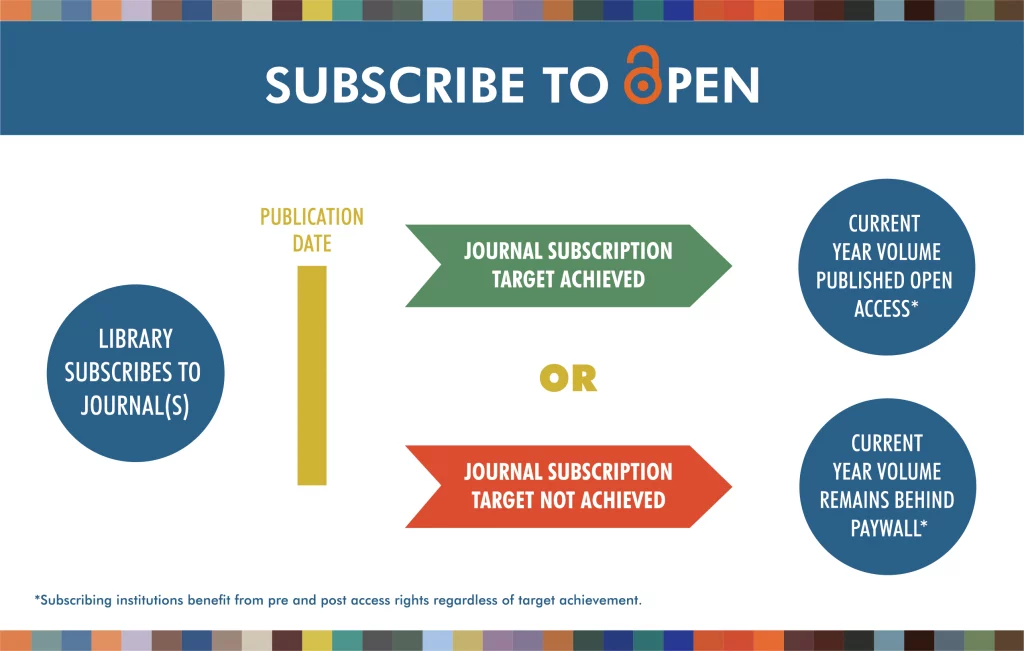This April, Annual Reviews announced that for 2023 they will offer all 51 of their journals under the Subscribe to Open (S2O) business model, with the intention of becoming a fully open access (OA) publisher.
Three years ago, I interviewed Richard Gallagher, President and Editor-in-Chief of Annual Reviews, and Kamran Naim, Director of Partnerships and Initiatives, about the organization’s rationale for pursuing OA and the details of S2O. Since that time, I’ve kept in touch with Richard and have been intrigued by his strategy to expand the reach of S2O based on experimentation, iteration, learning, and evidence.
With this latest announcement expanding the S2O model to all of Annual Reviews’ publications, it was time to speak with Richard again!

Richard, for those not familiar with S2O, can you offer a brief definition?
S20 is a business model to convert entire volumes (years) of a journal to OA. It is applicable to all disciplines and to authors in all countries. Under S2O, Institutional customers continue to subscribe to the journals that their patrons value. If support is sufficient, new volumes are published OA under a Creative Commons license; if support is insufficient, the paywall is retained. So, it is a subscription model, not a voluntary donation approach.
One thing that is critical for any innovation, whether it be a business model or a new product launch, is the ability to iterate and adjust based on experimentation and evidence. Can you describe the steps you took, taking S2O from an idea to full implementation?
We went through four cycles of iterative development, each moving us towards the full roll-out. We did it all quite publicly and have shared information freely along the way.
The initial test was to remove the paywall on a single title, to assess the impact of OA. This was achieved courtesy of a grant from the Robert Wood Johnson Foundation (RWJF) to cover the publishing costs of the Annual Review of Public Health for one year. From the first month, it was clear that the impact on usage was huge.
We quickly set about phase two: identifying a viable route to OA. That proved to be rather elusive. APCs and Read and Publish models, impactful as they are, are not suited to Annual Reviews, and we were reduced to mulling over an approach to research funding bodies for direct support. The grant from the RWJF provided funds for some consulting support and Kamran suggested that we engage Raym Crow from Chain Bridge Group. This proved to be key. I clearly recall the proverbial light bulb switching on during the very first meeting with Raym. I was sure he’d given us an approach to test.
APCs and Read and Publish models, impactful as they are, are not suited to Annual Reviews…
Over many months, we worked out the details for an Annual Reviews offering. The last thing to fall into place was the name. Subscribe to Open (or just S2O) came to me on a day where I had overreached on a long run and ended up walking the last couple of miles. We made the decision not to trademark it, in the hope that other publishers would develop similar offerings.
S2O was piloted with five Annual Reviews titles in 2020 and results were sufficiently encouraging in terms of usage and finance to expand this to 8 titles for 2021 and 2022. Again, subscription levels were maintained, and usage grew dramatically. As of now, the first 15 offerings of volumes of Annual Reviews journals under S2O have been successful. This is encouraging, but as our sales are mostly multi-journal packages, these events were not full tests of the S2O business model.
The third round of development came from testing the details of our S2O proposition with librarians, and also with other publishers and funders who participate the S2O Community of Practice (CoP). A survey and discussions with librarians indicated that our S2O proposal may not provide sufficient incentives to retain all of the subscribers. To address this, we tweaked the offering to provide the following three additional features for subscribers: access to draft articles, called Reviews in Advance, that are posted ahead of publication; enhanced back volume access; and public acknowledgement of subscribers when non-subscribers use the content.
The original plan was more cautious, extending through 2032, but the COVID-19 pandemic reset the timeline.
We now feel ready to move to the fourth phase, aiming at conversion of all titles to full OA. The original plan was more cautious, extending through 2032, but the COVID-19 pandemic reset the timeline. In March 2020, we temporarily removed the paywall on all 51 journals and usage increased by a minimum of three-fold and a maximum (for the Annual Review of Virology) of more than 20-fold. This fueled the bolder plan of converting all titles in 2023. Bold, but not rash. At each stage we set criteria for full success, partial success, and failure, to avoid the temptation of post hoc justification, and we predicted specific risks, assessing them and working to overcome or minimize them.
This might sound like a very formal process, but it in practice it really wasn’t. We are a small team with a flat structure, and I’d say that almost all of the Annual Reviews staff have been involved in discussions or implementation. Advice and encouragement from our Board of Directors and Editorial Committees has also been crucial.
You were the first to experiment with S2O and there have been several iterations of similar models since your initial launch. How did you address feedback, confusion, and skepticism about the model?
Internally, the process described above was crucial. Externally, many colleagues in publishing were – and a fraction remain – skeptical. Some of this has been down to lack of understanding of the model, but even that is helpful as it illustrates how much work is required to familiarize the community with the S2O proposition. Pro-OA librarians (often members of the Community of Practice) and the Annual Reviews sales team have been especially valuable in fine tuning the offering and determining how best to describe it.
Critiques have centered around three topics.
- Sustainability: is this a genuine long-term prospect for OA publishing?
- Equity: should a small number of institutions be expected to carry the burden of payment?
- And breadth of applicability: what restrictions are imposed by the apparent need for an existing subscriber base?
The first question – whether S2O is sustainable – can only be answered retrospectively. Therefore, everyone has an opinion. Mine is that the next couple of years are crucial. If the S2O offerings currently in play – 138 journals from 12 publishers in 2023, and likely more in 2024 – succeed then I expect it will be establish as a mainstream approach to OA, alongside APCs and Read and Publish.
S2O permits institutions that can’t leverage Read & Publish programs to have a voice in the OA transition, and that’s important.
The second question is whether a relatively small fraction of potential user institutions carrying the burden of payment is fair. I think that it is. Annual Reviews has a subscriber base of around 3,000 institutions and, while potential user institutions run to the hundreds of thousands, current subscribers will continue to be the biggest users. Subscribers will receive a package of benefits that are not available to non-subscribers, including access to reviews ahead of formal publication, and permanent data rights. Additionally, S2O permits institutions that can’t leverage Read & Publish programs to have a voice in the OA transition, and that’s important.
Also, as S2O is adopted by other publishers, institutions will have access to more and more journals for which they are not part of the subscriber base.
Also, as S2O is adopted by other publishers, institutions will have access to more and more journals for which they are not part of the subscriber base. Large parts – theoretically, the entire literature – could be converted to OA using existing budgets. This includes parts of the literature that are currently problematic for OA. For example, S2O puts the social sciences and humanities on a par with biomedical research, and the work of authors in low- and middle-income countries is treated equally to work from wealthy countries.
On the third question, whether the use cases for S2O are restricted, I’d say not necessarily. “Born open” projects are perfectly feasible. Indeed, S2O-like book and monograph publishing programs, such as MIT Press’ Direct to Open and Central European University Press’ Opening the Future, are already in operation, and new S2O journals are in the planning stages (though not by us, at the moment).
Publishing OA under S2O is contingent on generating subscriptions, with the fall-back being paywall publishing. What would you say to the idea that this isn’t truly OA publishing, or that the will-it-or-won’t-it publish OA is a flaw?
All OA publishing, indeed publishing of all kinds, proceeds only if the required funding is in place. An article in a hybrid journal is OA only if the APC is paid. A Read and Publish deal requires funding for the OA component. And S2O requires subscription revenues. Journals funded using the S2O model certainly qualify as OA, and the approach compares favorably to the alternatives in many respects.
On the uncertainty over whether a journal will be OA year-by-year, again we just have to wait and see what happens. Success or failure is in the hands of the subscribing librarians, and their response to date has been encouraging.
“A model like S2O is something that librarians have been asking for, for many years. We need to move our mindset from procurement – where we focus on spending out our collection budgets – to really investing in the open future that we envision. Libraries are already stepping forward to support S2O and their institutional values. It is inspiring them.”
Curtis Brundy, Associate University Librarian for Scholarly Communication and Collections at Iowa State University.
If, as I hope, S2O is established as a route to OA, the likelihood that well-run, useful journals are funded year after year is very high. The will-it-or-won’t-it question issue will recede. There is even the possibility of increasing the subscriber base, leading to reductions in the cost of subscriptions.
In some fields, APC payments from research funders are a crucial component in journal income. Currently, funders, librarians and publishers are exploring how best to incorporate funder support into the S2O business model.
When will you be able to judge success?
We track renewals, so we will have some idea of where things stand pretty early in the renewal season. But we’ll only judge success, defined as publishing OA using S2O, on a journal-by-journal basis close to the publication dates (our titles publish once per year).
Real success in a business sense can only be judged in the long-term. If S2O succeeds year after year, say for 10 years, then we can call it a success.
We do have targets for the other major criteria for judging the success, namely usage that the journals enjoy and the new contexts in which the content is used. We mustn’t forget that this is the whole point!
And if you fail?
Other approaches to OA may become feasible – in fact, even with full success of S2O, we must be open to the possibility of models with still better features. The fallback at present is to return to paywall access if things go badly off track. Whatever happens, Annual Reviews will continue to pursue its mission for the progress of science and the benefit of society.
Discussion
3 Thoughts on "Annual Reviews’ Subscribe To Open: From Idea To Full Adoption"
Thank you, Ann, Richard and the full Annual Reviews team! This is very welcome news indeed! It may be mentioned here that in the recent IAP report on Predatory Journals and Conferences, the ‘author-pays’ model of OA implementation was singled out as particularly vulnerable to predation and the S2O, SCOAP3 and OLH models were identified as promising alternatives.
‘Author-pays’ OA or APC-based OA is like a stone balanced on the wrong end. Despite its popularity, it is bound to show its ill-effects and inconsistencies. The earlier the publishing world wakes up to this reality, the better for scholarly publishing.
Kudos to Annual Reviews! Thoroughly impressive to make 51 journals Open Access with a single initiative
What I find particularly magical about this story is that Richard Gallagher came to this epiphany on a run/walk; a good example of how self-care and mindfulness contribute to great ideas. 🙂 Thanks for the wonderful interview!



